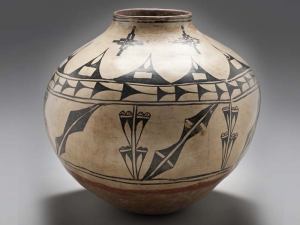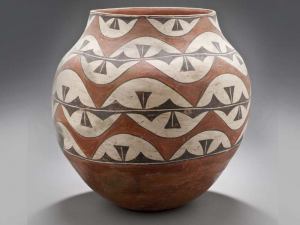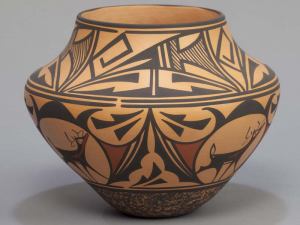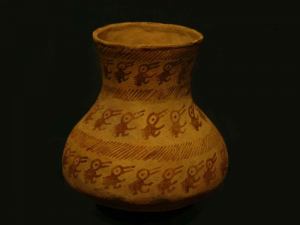Handcrafted Gifts and Souvenirs
Our handcrafted gifts come from the hearts of our talented artists. They represent the cultural spectrum of New Mexico and their works reflect its unique heritage. Fetishes, for example, are small, carved stone animals. They are used by Native American tribes throughout the Southwest and bring the qualities of the animal’s inner spirit to its owner. A number of our artists are inspired by traditional themes and ideas, but interpret them in new ways, such as painted and decorated gourds. Each of these gifts is something special, a reminder of the region’s timelessness.
We believe an inexpensive souvenir can still be high quality and a lasting reminder of a trip to White Sands National Monument. Our tee-shirts, for example, are 100% cotton and feature artistic designs. We offer a large selection of items from caps to cards that are easy to pack and make great gifts for friends and family.
These are the basic ingredients in Pueblo Indian pottery—an art that is more than two thousand years old. In ancient times, these were utilitarian pieces, used for cooking, for storing food and water, and in ceremonies. But even though pottery is easily broken and days were filled with hard labor, potters took the time to paint and decorate their pots, transforming them to an art form.
Today, most Pueblo pottery is made the same way it was hundreds of years ago. First, the clay is dug by hand—often at a site known only to family members. It is sifted many times, then mixed with sand, crushed rock, or ground pottery sherds for stability. Then water is added. The proportions aren’t measured except by look and feel, a skill passed through generations.




The Coil Method
The shape of the pot is created by the coil method. First, a flat base is patted and rolled. Then, the potter rolls a rope of clay to coil on top of the base. The coil must be of uniform thickness and contain no air bubbles. Coil upon coil are pressed together to form the walls of the pot. These are smoothed and thinned using a scraper, which is often a piece of gourd or a smooth stone. The potter uses no modern tool, and yet the pot’s walls are an even thickness, its shape is stable, and it is a near perfect circle—a feat of engineering.
After it is dry, the pot is usually sanded and coated with a clay slip. The potter will spend hours polishing it with a stone, sometimes one passed on by a cherished relative. In some cases, designs are painted on using colored clay slips. The technique called sgraffito involves cutting or scraping through the slip to create a design in the clay underneath. While commericial kilns are sometimes used, most Native Americans prefer the magical, if somewhat unpredictable results of an outdoor fire. Acombination of wood and cow or sheep dung fuel the fire to very high temperatures. If the pot is smothered during the firing, it will turn black from the smoke. Many contemporary Native Americans make their living creating pottery using traditional techniques and designs, but also incorporating their own modern artistry.
Pueblo Potters
Rachel Aragon
Acoma Pueblo
Linda Jo’Povi Askin
Santa Clara Pueblo
Myrtle Cata
San Felipe and San Juan Pueblos
Vickie Martinez
Santa Clara Pueblo
Mary Quintana
Cochiti Pueblo
Sometimes they would wear it as personal adornment, sometimes as part of elaborate ceremonial dress. In fact, jewelry was so important that materials were traded over networks that ranged for thousands of miles, even though there were no roads or horses. New Mexico was at the heart of this trade because of its turquoise mines in the area around what is now the town of Cerrillos. The brilliant blue stone was highly prized and was usually made into beads that were drilled and strung together into jewelry.
Today, there are several styles of Native American jewelry in the Southwest. New Mexico’s Pueblo Indians still make traditional jewelry from beads. These are sometimes made from rolling thin layers of stone or shell together into heishi. Materials now may come from all over the word and include gemstones, coral, and shells.
Turquoise
The Navajo, now known by their ancestral name Dine, are relative newcomers to the Southwest, having migrated in the 15th or early 16th century. They are known for fine silversmith work, a tradition which began in the mid-1800s. Dine jewelers readily adapted techniques and designs from both Pueblo Indians and Spanish colonists. Turquoise is often incorporated into their necklaces, bracelets, earrings, and belts.
The Zuni and Hopi Indians have established their own styles and create elegant jewelry that features inlaid stones. There is also an overlay technique that produces contrasting black and silver pieces. Just as modern materials have come into use, so have modern designs. Contemporary artisans bring their own interpretations to this traditional art form.
Native American Jewelers
Kenneth Aguilar
Santo Domingo Pueblo
Thomas Charley
Navajo
Daniel Coriz
Santo Domingo Pueblo
Jimmy Harrison
Navajo
Sunshine Reeves
Navajo
Rosetta Family
Santo Domingo Pueblo
Navajo Weavings – An ancestral gift
According to lore, it was Spider Woman, a powerful protector of the Dine people, who gave them the gift of fine weaving. It was a valuable gift indeed, for today Dine weavings are highly prized for their quality and artistry. Many Dine men and women, living on the vast reservation, depend upon weaving for their income. Spanish settlers brought the small, sturdy churro sheep to New Mexico when they began colonizing parts of the region in the late 1500s. Churro wool is exceptionally long and silky and Dine weavers quickly learned to make the most of its fiber. At first, weavings were mostly utilitarian—blankets and saddle blankets. But the owners of trading posts on the reservations sensed the marketability of rugs and showed weavers how to make them.
The oldest patterns of Dine weaving are based on the landscape and on the rich stories of their history and spiritual life. Trading post owners showed weavers examples of Oriental rugs, and soon elements of those designs became incorporated. Today, many weavers work within traditional designs, but others create their own stories. Colors sometimes come from the shade of the wool itself. Vegetal dyes in soft tones are made from boiling native plants. But the use of commercial analine dyes dates from the days of the trading posts and is considered authentic. Commercial dyes produce the bright colors in Dine textiles.
A few of the most popular styles include:
- Two Grey Hills – central diamond motif in blacks, browns, and greys
- Crystal and Wide Ruins – banded patterns, usually in vegetal dyes
- Burntwater – central design with border, usually vegetal dyes
- Storm Pattern – squares representing sacred mountains in the corners, pattern tells a story
- Teec Nos Pos – intricate patterns influenced by Oriental rugs
- Ganado Red – deep red color requires the use of commercial dye
- Yei and Yei-be-chai-figures represent spiritual beings with healing powers
- Blanket Revival – contemporary weavings using classic blanket patterns

